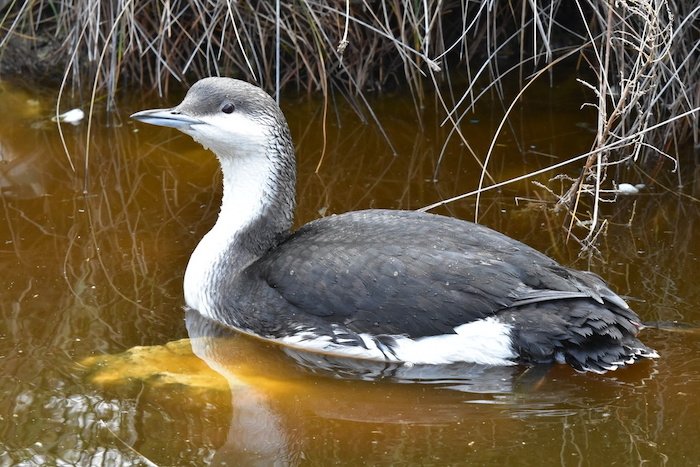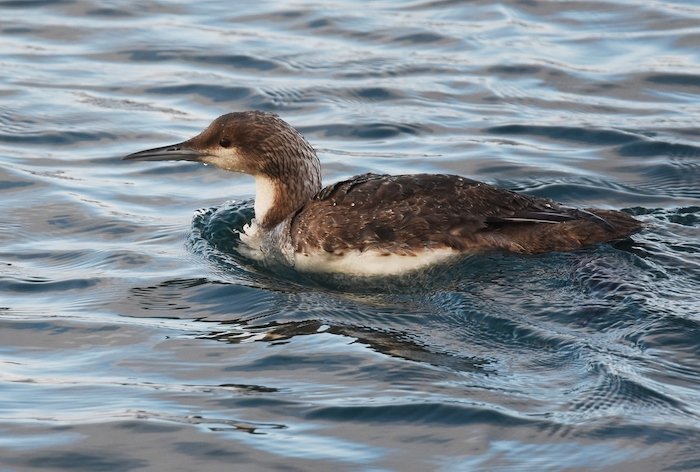Loony Yodelers
Observation by ChrisMcV, CC0 1.0, via iNaturalist
Gaviidae
by Inspector Barry Mins on March 19, 2024Hey kids, welcome back to our series on the mysteries of created kinds.
Last week, we met a group of small, colorful salamanders. This week, we go from cold-blooded to warm-blooded as we go searching for one of the craziest-sounding birds in the world.

This kind is migratory and has a large, widespread range in the Northern Hemisphere, from Florida to Russia, depending on the species and time of year. Migration distances vary even within the species, and the bird’s body condition worsens the longer it migrates.1 They tend to return to the same places on a yearly basis, making it easy to find them.2 They are predatory birds, munching on fish and crustaceans, with a preference for weakened or easy to catch prey.3 They live in large unmated groups or mated pairs.4 Mated pairs stay loyal to each other,5 unlike many other species when pairs separate or never form at all. When males occupy a new territory, they often change their song, known as a yodel.6
Nests are built along the shoreline, and both males and females share incubation duties.7 Once the eggs hatch, chicks grow rapidly, reaching 60% of adult weight by the time they fledge.8 Parents bring the chicks increasingly large fish that the chicks swallow whole.9
Has anyone figured it out yet? This week’s kind is the Gaviidae—the loons. There are five species of living loons, known best for their eerie call. Stay tuned for next week when we go looking for a small species of songbird with some patches of bright color.
Try out this fun word search!
Clue
Your clue for the week is:
All but one member of this kind have golden yellow crests on their heads. The one without a yellow crest has a bright red one instead.
Ask a Question
Have you ever had a question about created kinds but didn’t know who to ask? Have you ever wanted to learn more about your favorite kind? Well, now you can! You can ask me, Inspector Barry Mins, a question! Have your parents help you fill out this form, and you might get your question answered in my column! If you have any questions about created kinds, feel free to send them my way!
Footnotes
- Carrie E. Gray, James D. Paruk, Christopher R. DeSorbo, Lucas J. Savoy, David E. Yates, Michael D. Chickering, Rick B. Gray, Kate M. Taylor, Nina Schoch, William Hanson, Darwin Long IV, John Cooley, and David C. Evers, “Body Mass in Common Loons (Gavia immer) Strongly Associated with Migration Distance,” Waterbirds 37, no. sp1 (2014): 64–75, https://briwildlife.org/wp-content/cache/mendeley-file-cache/ce033b24-df88-3682-97ae-267afbf9a150.pdf.
- James D. Paruk, Michael D. Chickering, Hannah Uher-Koch, Andrew East, Daniel Poleschook, Virginia Gumm, William Hanson, Evan M. Adams, Kristin A. Kovach, David C. Evers, Darwin Long IV, “Winter Site Fidelity and Winter Movements in Common Loon (Gavia immer) Across North America,” The Condor 117, no. 4 (2015): 485–493, https://www.researchgate.net/publication/282390507_Winter_site_fidelity_and_winter_movements_in_Common_Loons_Gavia_immer_across_North_America.
- J. F. Barr, “Aspects of Common Loon (Gavia immer) Feeding Biology on Its Breeding Ground,” Hydrobiologia 321 (1996): 119–144, https://link.springer.com/article/10.1007/BF00023169.
- T. E. Reimchen and S. Douglas, “Observations of Loons (Gavia immer and G. stellata) at a Bog Lake on the Queen Charlotte Islands,” Canadian Field Naturalist 94, no. 4 (1980): 398–404, https://web.uvic.ca/~reimlab/loon_research/Observations%20of%20Loons%20CFN.pdf.
- Walter H. Piper, David C. Evers, Michael W. Meyer, Keren B. Tischler, Joseph D. Kaplan, and Robert C. Fleischer, “Genetic Monogamy in the Common Loon (Gavia immer),” Behavioral Ecology and Sociobiology 41 (1997): 25–31, https://link.springer.com/article/10.1007/s002650050360.
- Charles Walcott, John M. Mager, and Walter Piper, “Changing Territories, Changing Tunes: Male Loons, Gavia immer, Change Their Vocalizations When They Change Territories,” Animal Behaviour 71, no. 3 (2006): 673–683, https://crcooper01.people.ysu.edu/Walcott%20et%20al%202006.pdf.
- G. Agren and S. Sjölander, “Reproductive Behavior of the Yellow-Billed Loon, Gavia adamsii,” The Condor 78 (1976): 454–463, https://sora.unm.edu/sites/default/files/journals/condor/v078n04/p0454-p0463.pdf.
- Daniel J. Rizzolo, Joel A. Schmutz, and John R. Speakman, “Fast and Efficient: Postnatal Growth and Energy Expenditure in an Artic-Breeding Waterbird, the Red-Throated Loon (Gavia stellata),” The Auk 132, no. 3 (2015): 657–670, https://www.researchgate.net/profile/Daniel-Rizzolo/publication/277666276_Fast_and_efficient_Postnatal_growth_and_energy_expenditure_in_an_Arctic-breeding_waterbird_the_Red-throated_Loon_Gavia_stellata/links/559b013d08ae21086d277deb/Fast-and-efficient-Postnatal-growth-and-energy-expenditure-in-an-Arctic-breeding-waterbird-the-Red-throated-Loon-Gavia-stellata.pdf.
- T. E. Reimchen and Sheila Douglas, “Feeding Schedule and Daily Food Consumption in Red-Throated Loons (Gavia stellata) over the Prefledgling Period,” The Auk 101, no. 3 (1984): 593–599, https://web.uvic.ca/~reimlab/Feeding%20Schedule%20Auk.pdf.
- © 2024 Answers in Genesis
- Privacy Policy
- Contact
- About





